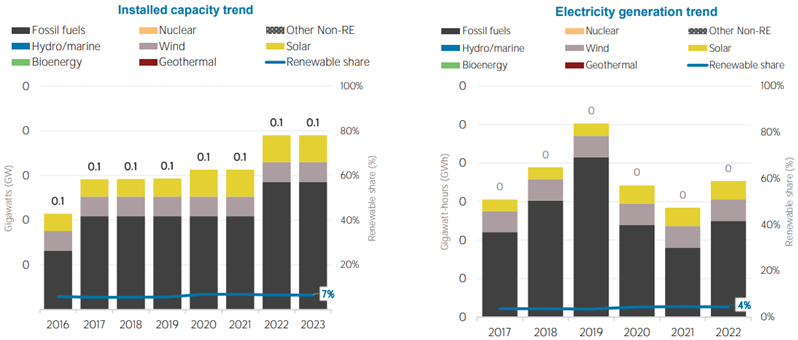Saint Kitts and Nevis (also referred to as SKN), also known as the Federation of Saint Christopher and Nevis, is a small two-island nation in the Caribbean. It is the smallest country in the Americas by both land area and population, with around 48,000 residents. [1] Saint Kitts, the larger of the two islands, is separated from Nevis by a narrow channel called The Narrows.
In 2016, Saint Kitts and Nevis submitted its first Nationally Determined Contribution (NDC) as part of the Paris Agreement on climate change. The NDC outlines measures to increase renewable energy use, reduce energy consumption, and address issues in water, agriculture, and coastal infrastructure. The country aims to reduce its greenhouse gas emissions by 22 percent by 2025 and 2030, and by 35 percent by 2030, compared to a business-as-usual scenario. These targets are conditional on receiving financial and technological support. [2]
On October 25, 2021, Saint Kitts and Nevis submitted a more ambitious updated NDC to the United Nations Framework Convention on Climate Change. By 2030, the country aims to produce all its electricity from renewable sources, improve transmission and distribution efficiency, start electrifying its vehicle fleet, and develop infrastructure for electric vehicles. [3]

Figure: L-R: Installed Capacity in SKN; Electricity generation in SKN [IRENA: Saint-Kitts-and-Nevis_Central-America-and-the-Caribbean_RE_SP.pdf ]
As of 2022, the total installed conventional capacity was over 78 MW, with renewable energy contributing approximately 11 percent to the energy mix. [4]
Solar power plays a significant role in the energy transition. The SKN-100 project includes the installation of solar panels on public buildings. Additionally, a 35.7 MW solar PV and battery energy storage project is expected to be operational by 2025. [5]
As of 2024, specific green hydrogen production projects have not yet been initiated, however, government’s commitment to achieving energy independence and transitioning to renewable energy sources lays the groundwork for future green hydrogen initiatives
[4] 2022-Energy-Report-Card-St-Kitts-and-Nevis.pdf
[5] Renewable Energy Transition in St. Kitts and Nevis: Progress and Challenges | WINNFM 98.9
The ongoing development of renewable energy infrastructure, such as solar and wind projects, enhances the feasibility of green hydrogen production in the future. Green hydrogen could serve as a clean energy carrier and support sectors like transportation and industry. While no specific green hydrogen projects have been reported as of 2024, the government’s proactive approach to renewable energy positions Saint Kitts and Nevis favorably for potential green hydrogen developments.
As of 2024, Saint Kitts and Nevis has not established a dedicated policy specifically for green hydrogen. However, the nation’s commitment to transitioning to renewable energy and achieving sustainability is evident through several key initiatives and policies that lay the groundwork for potential green hydrogen development.
The National Energy Policy, formulated over a decade ago, outlines the government’s vision to transform Saint Kitts and Nevis into “the smallest green nation in the Western Hemisphere.” The policy emphasizes the diversification of energy sources, increased utilization of renewable energy technologies, and the development of an appropriate legal and institutional framework to support sustainable energy activities. While the NEP does not explicitly address green hydrogen, its focus on renewable energy integration creates a conducive environment for future green hydrogen projects.
As of 2024, Saint Kitts and Nevis has not established a dedicated regulatory framework specifically for green hydrogen .
In 2022, construction began on a 35.7 MW solar photovoltaic farm paired with 44.2 MWh of lithium-ion battery storage. This project is designed to supply approximately one-third of the nation’s energy needs through a 20-year power purchase agreement with the St. Kitts Electricity Company (SKELEC). [1]
In October 2024, the government launched a renewable energy project at the Basseterre Deep Water Port, featuring a renewable energy-powered microgrid with innovative Vertical Axis Wind Turbine technology. This system is engineered to withstand the region’s severe weather conditions, contributing to the port’s goal of achieving carbon neutrality. [2]
The island of Nevis possesses significant geothermal potential. In May 2024, discussions were held with investment firms to advance the geothermal project, aiming to diversify the energy mix and provide a stable, renewable power source.

Figure: Renewable Energy potential and installation as of 2022 [ 2022-Energy-Report-Card-St-Kitts-and-Nevis.pdf ]
International partnerships have played a crucial role in promoting renewable energy projects. The Citizenship by Investment (CBI) program has drawn foreign investments into green energy, while policies such as feed-in tariffs are designed to encourage private-sector involvement. Organizations like the European Union, the Global Environment Facility, and the Caribbean Centre for Renewable Energy and Energy Efficiency (CCREEE) have provided both technical expertise and funding.
As of 2024, SKN does not have established facilities for manufacturing electrolysers, which are essential for green hydrogen production.
While Saint Kitts and Nevis has not yet embarked on specific green hydrogen production projects, the nation’s strategic policies, international collaborations, and ongoing renewable energy developments create a favorable environment for future exploration and potential implementation of green hydrogen technologies.